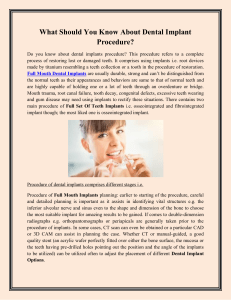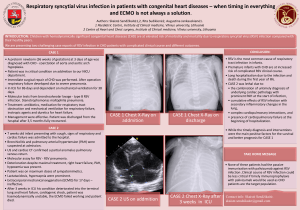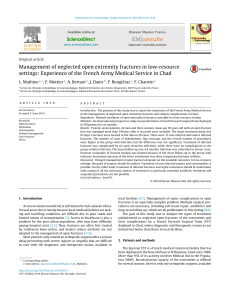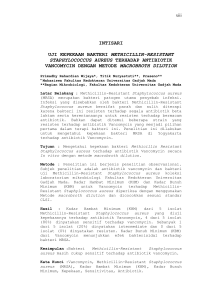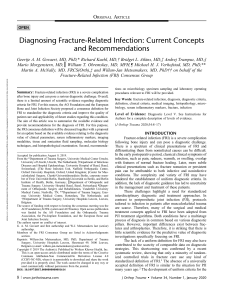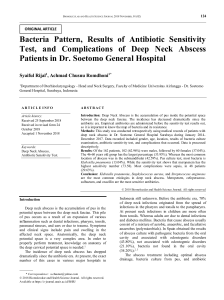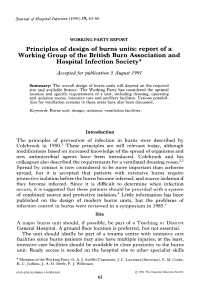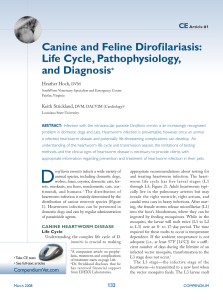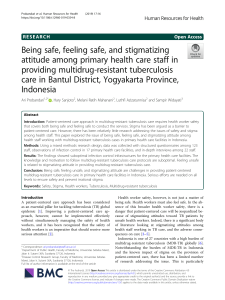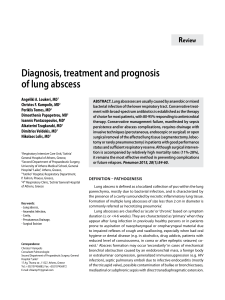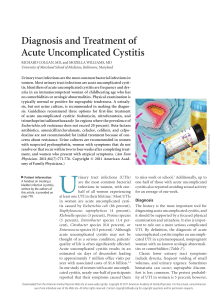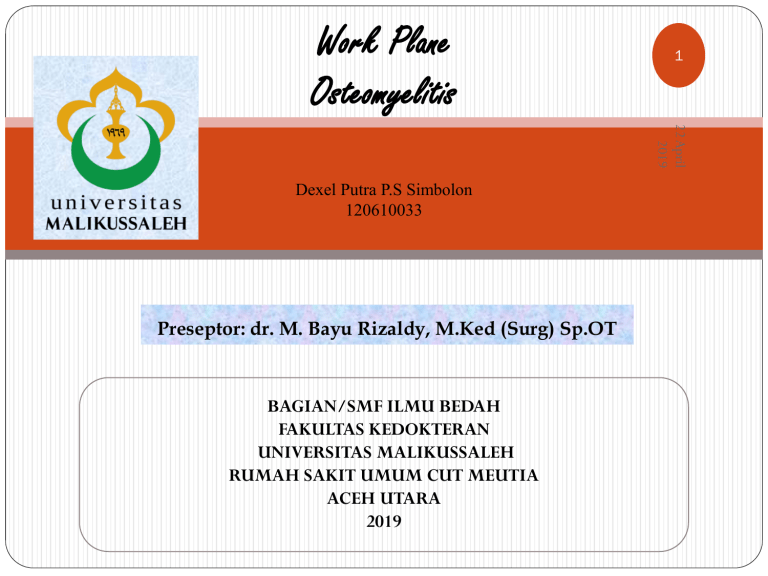
Work Plane Osteomyelitis 1 22 April 2019 Dexel Putra P.S Simbolon 120610033 Preseptor: dr. M. Bayu Rizaldy, M.Ked (Surg) Sp.OT BAGIAN/SMF ILMU BEDAH FAKULTAS KEDOKTERAN UNIVERSITAS MALIKUSSALEH RUMAH SAKIT UMUM CUT MEUTIA ACEH UTARA 2019 EPIDEMIOLOGY The overall prevalence is 1 case per 5,000 children. The prevalence of neonates is around 1 case per 1,000 events. The prevalence of osteomyelitis after trauma to the foot is around 16% (30-40% in patients with DM). Acute hematogenous osteomyelitis is common in children, boys are more often affected than women (3: 1). The bones that are often affected are the longest and most common bones are the femur, tibia, humerus, radius, ulna, fibula. In adults hematogenous infections are usually the most common in the vertebrae compared to long bones. Adults are exposed to a decrease in body defenses due to weakness, illness or drugs. Diabetes is also associated with osteomyelitis, transient or induced immunosuppression increases predisposing factors, trauma determines the site of infection, probably caused by a small hematoma or accumulation of fluid in the bone ETIOLOGY Staphylococcus aureus is the most common organism causing acute osteomiletis, which is acute, which is approximately 90% of cases. The entry point of bacteria is through injured and infected skin, blisters, and pimples or boils. Sometimes it can also be through the mucous membrane of the mucous membrane of the upper airway as a complication of infection of the throat or nose. In addition, other bacteria that can cause osteomyelitis are Streptococcus and Pneumococcus, especially in infants. The most common organism causing osteomyelitis is based on the age of the patient: Infants (<1 year) - Grup B Streptococci Staphylococcus auereus Escherichia coli Children (1 - 16 years) - Staphylococcus auereus Streptococcus pyogenes Haemophilus influenzae Adults (> 16 years) - Staphylococcus epidermidis Staphylococcus auereus Pseudomonas aeruginosa Serratia mercescens Escherichia coli OSTEOMYELITIS Routes of infection 1. 2. 3. Hematogenous spread, most common. Extension from a contiguous site. Direct implantation. OSTEOMYELITIS: Sites of involvement: The long bones of the extremities are most commonly involved The most common sites are the distal femur and proximal tibia metaphysis metaphysis Metaphysis OSTEOMYELITIS Sites of involvement: Influenced by the vascular circulation, which varies with age. Neonates: the metaphyseal vessels penetrate the growth plate, resulting in frequent infection of the metaphysis, epiphysis or both. Children: metaphyseal. Adults: epiphyses and subchondral regions. OSTEOMYELITIS Risk factors It occurs most frequently in children and young adults. 2. Diabetes mellitus (especially involving the foot) 3. Compromised immunity (including AIDS) 4. Sickle-cell disease 1. OSTEOMYELITIS Stages : Acute Sub acute Chronic. OSTEOMYELITIS Pathophysiology Necrosis of the bone within first 48hrs. Spread of bacteria and inflammation within the shaft of the bone and may percolate through the haversian systems to reach the periosteum. In children, the periosteum is loosely attached to the cortex; therefore sizable subperiosteal abscess formation occurs. Further ischemia and bone necrosis occurs. OSTEOMYELITIS SEQUENCE OF INFECTION: Once localized in bone, the bacteria proliferate and induce an acute inflammatory reaction and cause cell death. Dead pieces of bone is known as the sequestrum. sequestrum After the first week chronic inflammatory cells become more numerous with the release of cytokines and deposition of new bone formation at the periphery. New bone may be deposited as a sleeve of living tissue known as the Involucrum Involucrum Brodie abscess: is a small intraosseus abscess that frequently involves the cortex and is walled off reactive bone. In infants epiphyseal infection may spread to the adjacent joint and causes septic or suppurative arthritis; may lead to permanent disability. Pathophysiology of osteomyelitis The primary site of infection is usually in the metaphysial region •The infection may spread to involve the cortex and form a subperiosteal abscess; may spread into the medullary cavity •Rarely, may spread into the adjacent joint space. sequestrum OSTEOMYELITIS OSTEOMYELITIS Clinical Course: Fever ,chills, malaise, marked to intense throbbing pain over the affected region. Diagnosis; Sign/symptoms. X-ray: a destructive lytic focus surrounded by edema and a sclerotic rim Blood cultures: +ve in 70% Biopsy OSTEOMYELITIS Rx : Pain relief Parenteral antibiotics for at least 2 weeks, followed by oral antibiotics for at least 4 weeks Surgical decompression and removal of any dead bone Rehabilitation. OSTEOMYELITIS Chronicity may develop with: delay in diagnosis extensive bone necrosis abbreviated antibiotic therapy inadequate surgical debridement weakened host defenses OSTEOMYELITIS Complications: Pathologic fracture. Secondary amyloidosis Endocarditis Sepsis Squamous cell carcinoma if the infection creates a sinus tract. Rarely sarcoma in the affected bone Thank You.
